|
Salvage Drum
A Salvage Drum is an outer container used for shipping a leaking, damaged or non-compliant drum containing hazardous materials. Several designs are available. Originally designed to be greater than, or equal to, the construction and performance specifics of an inner container, the Performance Oriented Packaging Standards (POPS) of the US Department of Transportation requirement was that the Salvage Drum be at least a 'Z' (Packing Group III) solids container. Convinced that this was not an acceptable test for a Salvage Drum, on January 1, 1998, the 'T' Salvage Drum (1A2T) became the UN recommended salvage packaging for international shipments. The US-DOT, per 49 CFR 173.3, also recognizes the 'T' Salvage Drum for shipments within the US. Unlike the original 49 CFR Salvage Drum requirement, the 'T' Salvage Drum is most commonly an steel drum that, meets UN Model Regulations test requirement 6.1.5.1.11, which specifies that when filled with water, the drum can qualify for Packing G ... [...More Info...] [...Related Items...] OR: [Wikipedia] [Google] [Baidu] |
Drum (container)
A drum (also called a barrel) is a cylindrical shipping container used for shipping bulk cargo. Drums can be made of steel, dense paperboard (commonly called a fiber drum), or plastic, and are generally used for the transportation and storage of liquids and powders. Drums are often stackable, and have dimensions designed for efficient warehouse and logistics use. This type of packaging is frequently certified for transporting dangerous goods. Proper shipment requires the drum to comply with all applicable regulations. Background It is common to hear a drum referred to as a barrel and the two terms are used nearly interchangeably. Many drums nominally measure just under tall with a diameter just under , and have a common nominal volume of whereas the barrel volume of crude oil is . In the United States, drums are also in common use and have the same height. This allows easy stacking of mixed pallets. Barrels can be constructed of plastic, laminated paperboard or steel. Th ... [...More Info...] [...Related Items...] OR: [Wikipedia] [Google] [Baidu] |
Hazardous Material
Dangerous goods, abbreviated DG, are substances that when transported are a risk to health, safety, property or the environment. Certain dangerous goods that pose risks even when not being transported are known as hazardous materials ( syllabically abbreviated as HAZMAT or hazmat). An example for dangerous goods is hazardous waste which is waste that has substantial or potential threats to public health or the environment. Hazardous materials are often subject to chemical regulations. Hazmat teams are personnel specially trained to handle dangerous goods, which include materials that are radioactive, flammable, explosive, corrosive, oxidizing, asphyxiating, biohazardous, toxic, pathogenic, or allergenic. Also included are physical conditions such as compressed gases and liquids or hot materials, including all goods containing such materials or chemicals, or may have other characteristics that render them hazardous in specific circumstances. Dangerous goods are often indicated ... [...More Info...] [...Related Items...] OR: [Wikipedia] [Google] [Baidu] |
US Department Of Transportation
The United States Department of Transportation (USDOT or DOT) is one of the executive departments of the U.S. federal government. It is headed by the secretary of transportation, who reports directly to the President of the United States and is a member of the president's Cabinet. The department's mission is "to develop and coordinate policies that will provide an efficient and economical national transportation system, with due regard for need, the environment, and the national defense." History Prior to the creation of the Department of Transportation, its functions were administered by the under secretary of commerce for transportation. In 1965, Najeeb Halaby, administrator of the Federal Aviation Agency (predecessor to the Federal Aviation Administration, FAA), suggested to President Lyndon B. Johnson that transportation be elevated to a cabinet-level post, and that the FAA be folded into the DOT. It was established by Congress in the Department of Transportation Act ... [...More Info...] [...Related Items...] OR: [Wikipedia] [Google] [Baidu] |
UN Recommendations On The Transport Of Dangerous Goods
The ''UN Recommendations on the Transport of Dangerous Goods'' are contained in thprepared by the Subcommittee of Experts on the Transport of Dangerous Goods of the United Nations Economic and Social Council (ECOSOC). They cover the transport of dangerous goods by all modes of transport except by bulk tanker. They are not obligatory or legally binding on individual countries, but have gained a wide degree of international acceptance: they form the basis of several international agreements and many national laws. "Dangerous goods" (also known as "hazardous materials" or "HAZMAT" in the United States) may be a pure chemical substance (for example, trinitrotoluene (TNT), nitroglycerin), mixtures (for example, dynamite, gunpowder) or manufactured articles (for example, ammunition, fireworks). The transport hazards that they pose are grouped into nine classes, which may be subdivided into divisions and/or packing groups. The most common dangerous goods are assigned a UN number, a fou ... [...More Info...] [...Related Items...] OR: [Wikipedia] [Google] [Baidu] |
Drum (container)
A drum (also called a barrel) is a cylindrical shipping container used for shipping bulk cargo. Drums can be made of steel, dense paperboard (commonly called a fiber drum), or plastic, and are generally used for the transportation and storage of liquids and powders. Drums are often stackable, and have dimensions designed for efficient warehouse and logistics use. This type of packaging is frequently certified for transporting dangerous goods. Proper shipment requires the drum to comply with all applicable regulations. Background It is common to hear a drum referred to as a barrel and the two terms are used nearly interchangeably. Many drums nominally measure just under tall with a diameter just under , and have a common nominal volume of whereas the barrel volume of crude oil is . In the United States, drums are also in common use and have the same height. This allows easy stacking of mixed pallets. Barrels can be constructed of plastic, laminated paperboard or steel. Th ... [...More Info...] [...Related Items...] OR: [Wikipedia] [Google] [Baidu] |
Package Testing
Package testing or packaging testing involves the measurement of a characteristic or property involved with packaging. This includes packaging materials, packaging components, primary packages, shipping containers, and unit loads, as well as the associated processes. Testing measures the effects and interactions of the levels of packaging, the package contents, external forces, and end-use. It can involve controlled laboratory experiments, subjective evaluations by people, or field testing. Documentation is important: formal test method, test report, photographs, video, etc. Testing can be a qualitative property, qualitative or Quantitative property, quantitative procedure. Package testing is often a physical test. With some types of packaging such as food and pharmaceuticals, chemical tests are conducted to determine suitability of food contact materials. Testing programs range from simple tests with little replication (statistics), replication to more thorough experimenta ... [...More Info...] [...Related Items...] OR: [Wikipedia] [Google] [Baidu] |
Containers
A container is any receptacle or enclosure for holding a product used in storage, packaging, and transportation, including shipping. Things kept inside of a container are protected on several sides by being inside of its structure. The term is most frequently applied to devices made from materials that are durable and are often partly or completely rigid. A container can also be considered as a basic tool, consisting of any device creating a partially or fully enclosed space that can be used to contain, store, and transport objects or materials. History Humans have used containers for at least 100,000 years, and possibly for millions of years.Clive Gamble, ''Origins and Revolutions: Human Identity in Earliest Prehistory'' (2007), p. 204. The first containers were probably invented for storing food, allowing early humans to preserve more of their food for a longer time, to carry it more easily, and also to protect it from other animals. The development of food storage cont ... [...More Info...] [...Related Items...] OR: [Wikipedia] [Google] [Baidu] |
_(8250838700).jpg)



